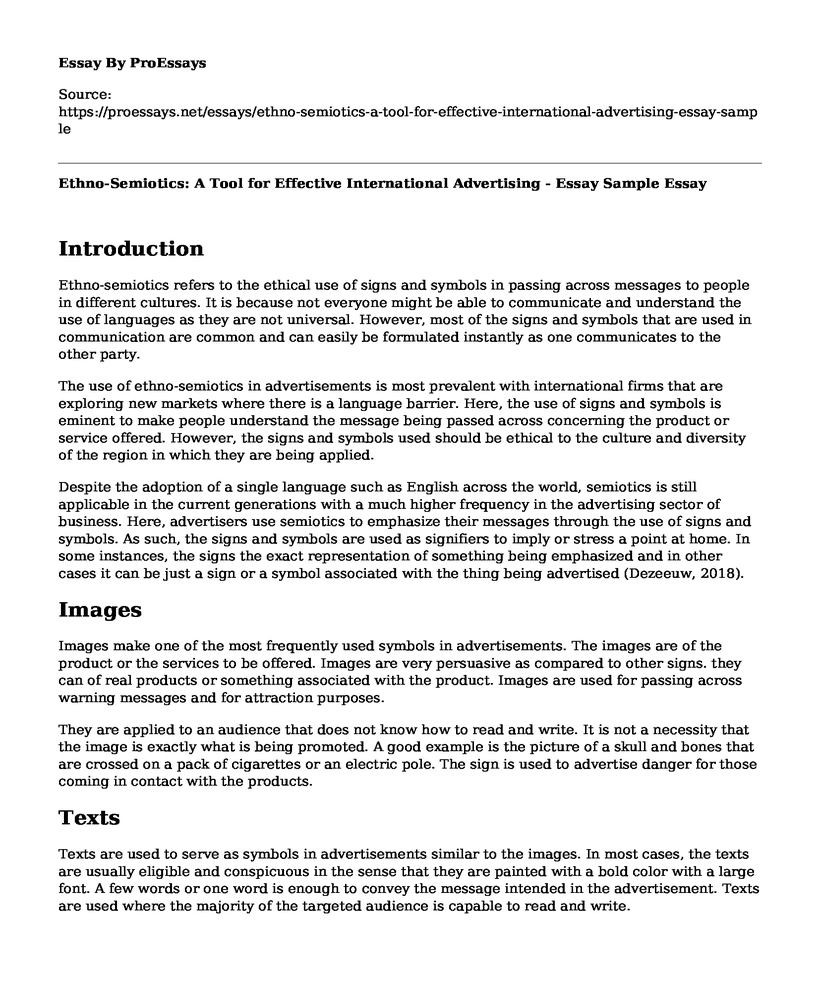Introduction
Ethno-semiotics refers to the ethical use of signs and symbols in passing across messages to people in different cultures. It is because not everyone might be able to communicate and understand the use of languages as they are not universal. However, most of the signs and symbols that are used in communication are common and can easily be formulated instantly as one communicates to the other party.
The use of ethno-semiotics in advertisements is most prevalent with international firms that are exploring new markets where there is a language barrier. Here, the use of signs and symbols is eminent to make people understand the message being passed across concerning the product or service offered. However, the signs and symbols used should be ethical to the culture and diversity of the region in which they are being applied.
Despite the adoption of a single language such as English across the world, semiotics is still applicable in the current generations with a much higher frequency in the advertising sector of business. Here, advertisers use semiotics to emphasize their messages through the use of signs and symbols. As such, the signs and symbols are used as signifiers to imply or stress a point at home. In some instances, the signs the exact representation of something being emphasized and in other cases it can be just a sign or a symbol associated with the thing being advertised (Dezeeuw, 2018).
Images
Images make one of the most frequently used symbols in advertisements. The images are of the product or the services to be offered. Images are very persuasive as compared to other signs. they can of real products or something associated with the product. Images are used for passing across warning messages and for attraction purposes.
They are applied to an audience that does not know how to read and write. It is not a necessity that the image is exactly what is being promoted. A good example is the picture of a skull and bones that are crossed on a pack of cigarettes or an electric pole. The sign is used to advertise danger for those coming in contact with the products.
Texts
Texts are used to serve as symbols in advertisements similar to the images. In most cases, the texts are usually eligible and conspicuous in the sense that they are painted with a bold color with a large font. A few words or one word is enough to convey the message intended in the advertisement. Texts are used where the majority of the targeted audience is capable to read and write.
Texts are also used to reinforce the message conveyed by an image when they are used alongside each other. For instance, in a political advertisement, the word "Socialist" or "Communist" might be flashed across the screen to portray the policies and the political perspective of a candidate to his audience. Texts are mostly used in organizations and learning institutions such as schools.
Sounds
Not only are symbols and signs visual in nature, but they can also as well as be audible. Music is a perfect universal example used by advertisers to convey the mood of the message to their audience. There are unique recognized sounds or rather music that when used by an advertiser, the audience understands the message being conveyed. For example, the jungle bells will imply Christmas, and the sound of a cow mowing will imply milk in any advertisement. However, most advertisements involving the use of sounds usually incorporate texts or images or both. It is because sounds are slightly difficult to interpret and understand. The use of sound usually targets young children and those who are not able to read and write.
Ethno-semiotic to some extent implies the general theory of signs and symbolism where it is divided into pragmatics, semantics, and syntactic. Semantics tries to look at the relationship between signifiers like texts and phrases together with what they stand for, that is their denotations. For instance, young can imply a baby, puppy, kitten, or piglet. Syntactics on the other hand, refer to the formal structure in which texts are to be arranged to create a well-communicated sentence. It takes grammar into account. Lastly, pragmatics refers to the relationship between signs and the influence that they have on people that use them.
In addition to the advertisement, semiotics involves the study of the use of signs and symbols in a bid to understand various cultures and any social changes that might occur. The above also incorporates the social traditions and practices of a community, their levels of psychology and etiquette, and how the targeted customers respond to images, texts, and sounds.
When businesses enter new markets, the culture and social experience of the natives is to shape the way they will have to understand and process the signs and symbols (Arboledas, 2017). Therefore, all semiotic advertisements that are made by business especially in foreign markets must be holistically implemented through the consideration of all the social and cultural issues and perceptions that the native people possess and adhere to.
References
Arboledas, S. (2017, September 22). Semiotics in Marketing Communications. Retrieved from https://www.business2community.com/communications/semiotics-marketing-communications-01921737
Dezeeuw, K. (2018, February 2). The Use of Semiotic Storytelling in Advertising. Retrieved from https://www.zionandzion.com/use-semiotic-storytelling-advertising/
Cite this page
Ethno-Semiotics: A Tool for Effective International Advertising - Essay Sample. (2023, Mar 29). Retrieved from https://proessays.net/essays/ethno-semiotics-a-tool-for-effective-international-advertising-essay-sample
If you are the original author of this essay and no longer wish to have it published on the ProEssays website, please click below to request its removal:
- Essay Example: Analysis of the Coca-Cola Advertisement that Addresses the Issue of Multiculturalism
- Target Market of Healthy Horizon Medical and Weight Loss Center Paper Example
- Critical Thinking on Business Ethics Paper Example
- Ambush Marketing Essay Example
- High-Tech Drug Production: Impact on Global Supply Chain - Essay Sample
- Organizations' Strategies to Satisfy Customers and Outshine Competitors - Essay Sample
- Essay Example on Home Baking: An Alternative to Consumerism & Decentralized Farming







